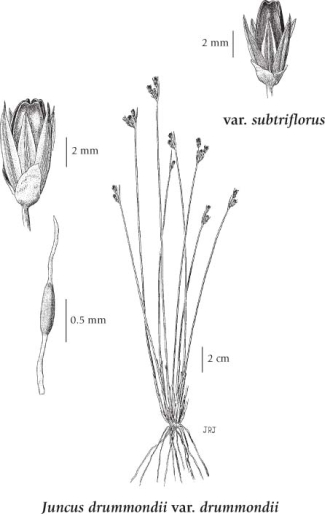Juncus drummondii E. Mey. var. drummondii
Drummond's rush
Juncaceae (Rush family)
Introduction to Vascular Plants
Drummond's rush
Juncaceae (Rush family)
Introduction to Vascular Plants
Map
Distribution of Juncus drummondii var. drummondii
Click here to view the full interactive map and legend
Species Information
General:
Perennial tufted herb from short rhizomes; stems wiry, erect, 15-40 cm tall.
Leaves:
Reduced to sheaths with short awns at the base of the stem, or the uppermost of the basal sheaths with blades less than 1 cm long.
Flowers:
Inflorescence a loose head with 1 to 4, nearly terminal flowers, appearing as if it is on the side of the stem; perianth segments green to brown, pointed, 5-7 mm long, the inner ones slightly shorter; stamens 6; anthers about 1.5 mm long, shorter than the filaments; involucral bract 1-3 cm long, cylindrical, resembling a continuation of the stem.
Fruits:
Capsules, cylindrical, notched, longer than the perianth segments; seeds spindle-shaped, 0.5 mm long with long, tail-like appendages at each end of the seed.
Notes:
Two varieties occur in W North America. Our BC material has been identified as var. drummondii but var. subtriflorus can be expected in S BC.
1. Capsules usually at least 1 mm longer than the perianth segments; perianth 5-6 mm long.................. var. subtriflorus (E. Mey.) C.L. Hitchc.
1. Capsules about equal to the perianth segments; perianth 6-7 mm long..................var. drummondii
Illustration

If more than one illustration is available for a species (e.g., separate illustrations were provided for two subspecies) then links to the separate images will be provided below. Note that individual subspecies or varietal illustrations are not always available.
Illustration Source: The Illustrated Flora of British Columbia
